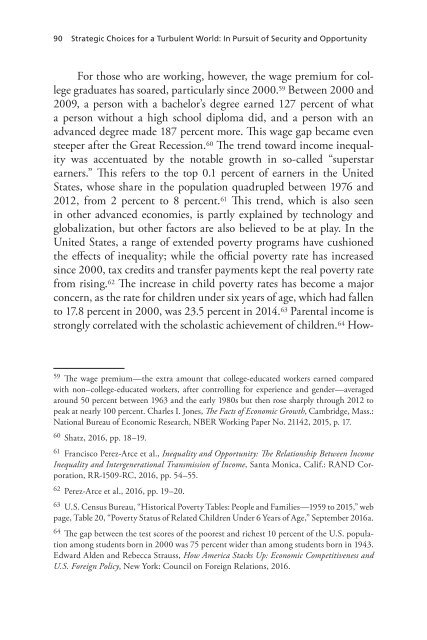Create successful ePaper yourself
Turn your PDF publications into a flip-book with our unique Google optimized e-Paper software.
90 Strategic Choices for a Turbulent World: In Pursuit of Security and Opportunity<br />
For those who are working, however, the wage premium for college<br />
graduates has soared, particularly since 2000. 59 Between 2000 and<br />
2009, a person with a bachelor’s degree earned 127 percent of what<br />
a person without a high school diploma did, and a person with an<br />
advanced degree made 187 percent more. This wage gap became even<br />
steeper after the Great Recession. 60 The trend toward income inequality<br />
was accentuated by the notable growth in so-called “superstar<br />
earners.” This refers to the top 0.1 percent of earners in the United<br />
States, whose share in the population quadrupled between 1976 and<br />
2012, from 2 percent to 8 percent. 61 This trend, which is also seen<br />
in other advanced economies, is partly explained by technology and<br />
globalization, but other factors are also believed to be at play. In the<br />
United States, a range of extended poverty programs have cushioned<br />
the effects of inequality; while the official poverty rate has increased<br />
since 2000, tax credits and transfer payments kept the real poverty rate<br />
from rising. 62 The increase in child poverty rates has become a major<br />
concern, as the rate for children under six years of age, which had fallen<br />
to 17.8 percent in 2000, was 23.5 percent in 2014. 63 Parental income is<br />
strongly correlated with the scholastic achievement of children. 64 How-<br />
59 The wage premium—the extra amount that college-educated workers earned compared<br />
with non–college-educated workers, after controlling for experience and gender—averaged<br />
around 50 percent between 1963 and the early 1980s but then rose sharply through 2012 to<br />
peak at nearly 100 percent. Charles I. Jones, The Facts of Economic Growth, Cambridge, Mass.:<br />
National Bureau of Economic Research, NBER Working Paper No. 21142, 2015, p. 17.<br />
60 Shatz, 2016, pp. 18–19.<br />
61 Francisco Perez-Arce et al., Inequality and Opportunity: The Relationship Between Income<br />
Inequality and Intergenerational Transmission of Income, Santa Monica, Calif.: RAND Corporation,<br />
RR-1509-RC, 2016, pp. 54–55.<br />
62 Perez-Arce et al., 2016, pp. 19–20.<br />
63 U.S. Census Bureau, “Historical Poverty Tables: People and Families—1959 to 2015,” web<br />
page, Table 20, “Poverty Status of Related Children Under 6 Years of Age,” September 2016a.<br />
64 The gap between the test scores of the poorest and richest 10 percent of the U.S. population<br />
among students born in 2000 was 75 percent wider than among students born in 1943.<br />
Edward Alden and Rebecca Strauss, How America Stacks Up: Economic Competitiveness and<br />
U.S. Foreign Policy, New York: Council on Foreign Relations, 2016.




